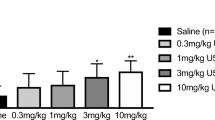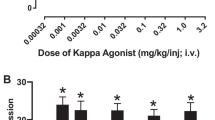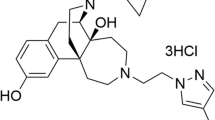Abstract
Rationale
Kappa-opioid receptor (KOPr) agonists have pre-clinical anti-cocaine and analgesic effects. However, side effects including sedation, dysphoria, aversion, anxiety and depression limit their therapeutic development. The unique structure of salvinorin A has been used to develop longer acting KOPr agonists.
Objectives
We evaluate two novel C-2 analogues of salvinorin A, ethoxymethyl ether Sal B (EOM Sal B) and β-tetrahydropyran Sal B (β-THP Sal B) alongside U50,488 for their ability to modulate cocaine-induced behaviours and side effects, pre-clinically.
Methods
Anti-cocaine properties of EOM Sal B were evaluated using the reinstatement model of drug seeking in self-administering rats. EOM Sal B and β-THP Sal B were evaluated for effects on cocaine-induced hyperactivity, spontaneous locomotor activity and sucrose self-administration. EOM Sal B and β-THP Sal B were evaluated for aversive, anxiogenic and depressive-like effects using conditioned place aversion (CPA), elevated plus maze (EPM) and forced swim tests (FSTs), respectively.
Results
EOM Sal B (0.1, 0.3 mg/kg, intraperitoneally (i.p.)) dose dependently attenuated drug seeking, and EOM Sal B (0.1 mg/kg, i.p.) and β-THP Sal B (1 mg/kg, i.p.) attenuated cocaine-induced hyperactivity. No effects on locomotor activity, open arm times (EPM) or swimming behaviours (FST) were seen with EOM (0.1 or 0.3 mg/kg, i.p.) or β-THP Sal B (1 or 2 mg/kg, i.p.). However, β-THP Sal B decreased time spent in the drug-paired chamber.
Conclusion
EOM Sal B is more potent than Sal A and β-THP Sal B in reducing drug-seeking behaviour with fewer side effects. EOM Sal B showed no effects on sucrose self-administration (0.1 mg/kg), locomotor, depressive-like, aversive-like or anxiolytic effects.









Similar content being viewed by others
References
Baker LE, Panos JJ, Killinger BA, Peet MM, Bell LM, Haliw LA, Walker SL (2009) Comparison of the discriminative stimulus effects of salvinorin A and its derivatives to U69,593 and U50,488 in rats. Psychopharmacology 203:203–211
Beardsley PM, Howard JL, Shelton KL, Carroll FI (2005) Differential effects of the novel kappa opioid receptor antagonist, JDTic, on reinstatement of cocaine-seeking induced by footshock stressors vs cocaine primes and its antidepressant-like effects in rats. Psychopharmacology 183(1):118–126
Beguin C, Richards MR, Wang YL, Chen Y, Liu-Chen LY, Ma ZZ, Lee DYW, Carlezon WA, Cohen BM (2005) Synthesis and in vitro pharmacological evaluation of salvinorin A analogues modified at C(2). Bioorg Med Chem Lett 15:2761–2765
Bohn L, Gainetdinov R, Lin F, Lefkowitz R, Caron M (2000) Mu-opioid receptor desensitization by beta-arrestin-2 determines morphine tolerance but not dependence. Nature 408(6813):720–723
Bossert JM, Marchant NJ, Calu DJ, Shaham Y (2013) The reinstatement model of drug relapse: recent neurobiological findings, emerging research topics, and translational research. Psychopharmacology 229(3):453–476
Braida D, Limonta V, Capurro V, Fadda P, Rubino T, Mascia P, Zani A, Gori E, Fratta W, Parolaro D, Sala M (2008) Involvement of kappa-opioid and endocannabinoid system on salvinorin A-induced reward. Biol Psychiatry 63:286–292
Braida D, Capurro V, Zani A, Rubino T, Vigano D, Parolaro D, Sala M (2009) Potential anxiolytic- and antidepressant-like effects of salvinorin A, the main active ingredient of Salvia divinorum, in rodents. Br J Pharmacol 157:844–853
Bruchas MR, Chavkin C (2010) Kinase cascades and ligand-directed signaling at the kappa opioid receptor. Psychopharmacology 210:137–147
Butelman ER, Mandau M, Tidgewell K, Prisinzano TE, Yuferov V, Kreek MJ (2007) Effects of salvinorin A, a kappa-opioid hallucinogen, on a neuroendocrine biomarker assay in nonhuman primates with high kappa-receptor homology to humans. J Pharmacol Exp Ther 320:300–306
Butelman ER, Prisinzano TE, Deng H, Rus S, Kreek MJ (2009) Unconditioned behavioral effects of the powerful kappa-opioid hallucinogen salvinorin A in nonhuman primates: fast onset and entry into cerebrospinal fluid. J Pharmacol Exp Ther 328:588–597
Butelman ER, Caspers M, Lovell KM, Kreek MJ, Prisinzano TE (2012) Behavioral effects and central nervous system levels of the broadly available kappa-agonist hallucinogen salvinorin A are affected by p-glycoprotein modulation in vivo. J Pharmacol Exp Ther 341:802–808
Carlezon WA, Beguin C, DiNieri JA, Baumann MH, Richards MR, Todtenkopf MS, Rothman RB, Ma ZZ, Lee DYW, Cohen BM (2006) Depressive-like effects of the kappa-opioid receptor agonist salvinorin A on behavior and neurochemistry in rats. J Pharmacol Exp Ther 316:440–447
Carr GV, Bangasser DA, Bethea T, Young M, Valentino RJ, Lucki I (2009) Antidepressant-like effects of kappa-opioid receptor antagonists in Wistar Kyoto rats. Neuropsychopharmacology 35:752–763
Chavkin C, Sud S, Jin WZ, Stewart J, Zjawiony JK, Siebert DJ, Toth BA, Hufeisen SJ, Roth BL (2004) Salvinorin A, an active component of the hallucinogenic sage Salvia divinorum is a highly efficacious kappa-opioid receptor agonist: structural and functional considerations. J Pharmacol Exp Ther 308:1197–1203
Chen J, Zhang R, Chen X, Wang C, Cai X, Liu H, Jiang Y, Liu C, Bai B (2015) Heterodimerization of human orexin receptor 1 and kappa opioid receptor promotes protein kinase A/cAMP-response element binding protein signaling via a Galphas-mediated mechanism. Cell Signal 27:1426–1438
Cunningham CW, Rothman RB, Prisinzano TE (2011) Neuropharmacology of the naturally occurring κ-opioid hallucinogen salvinorin A. Pharmacol Rev 63:316–347
Davis CM, Rice KC, Riley AL (2009) Opiate-agonist induced taste aversion learning in the Fischer 344 and Lewis inbred rat strains: evidence for differential mu opioid receptor activation. Pharmacol Biochem Behav 93:397–405
Di Chiara G, Imperato A (1988) Opposite effects of mu-opiate and kappa-opiate agonists on dopamine release in the nucleus accumbens and in the dorsal caudate of freely moving rats. J Pharmacol Exp Ther 244:1067–1080
DiMattio KM, Ehlert FJ, Liu-Chen LY (2015) Intrinsic relative activities of k opioid agonists in activating Gαproteins and internalising receptor: differences betweenhuman and mouse receptors. Eur J Pharmacol 761:235–244
Ebner SR, Roitman MF, Potter DN, Rachlin AB, Chartoff EH (2010) Depressive-like effects of the kappa opioid receptor agonist salvinorin A are associated with decreased phasic dopamine release in the nucleus accumbens. Psychopharmacology 210:241–252
Ehrich JM, Messinger DI, Knakal CR, Kuhar JR, Schattauer SS, Bruchas MR, Zweifel LS, Kieffer BL, Phillips PE, Chavkin C (2015) Kappa opioid receptor-induced aversion requires p38 MAPK activation in VTA dopamine neurons. The Journal of neuroscience: the official journal of the Society for Neuroscience 35:12917–12931
Endoh T, Matsuura H, Tanaka C, Nagase H (1992) Nor-binaltorphimine: a potent and selective kappa-opioid receptor antagonist with long-lasting activity in vivo. Arch Int Pharmacodyn Ther 316:30–42
Gallantine EL, Meert TF (2008) Antinociceptive and adverse effects of μ- and κ-opioid receptor agonists: a comparison of morphine and U50488-H. Basic Clin Pharmacol Toxicol 103:419–427
Gillett K, Harshberger E, Valdez GR (2013) Protracted withdrawal from ethanol and enhanced responsiveness stress: regulation via the dynorphin/kappa opioid receptor system. Alcohol 47:359–365
Glick SD, Visker KE, Maisonneuve IM (1998) Effects of cyclazocine on cocaine self-administration in rats. Eur J Pharmacol 357:9–14
Gore-Langton JK, Flax SM, Pomfrey RL, Wetzell BB, Riley AL (2015) Measures of the aversive effects of drugs: a comparison of conditioned taste and place aversions. Pharmacol Biochem Behav 134:99–105
Harden MT, Smith SE, Niehoff JA, McCurdy CR, Taylor GT (2012) Antidepressive effects of the kappa-opioid receptor agonist salvinorin A in a rat model of anhedonia. Behav Pharmacol 23:710–715
Harding WW, Tidgewell K, Schmidt M, Shah K, Dersch CM, Snyder J, Parrish D, Deschamps JR, Rothman RB, Prisinzano TE (2005) Salvinicins A and B, new neoclerodane diterpenes from Salvia divinorum. Org Lett 7:3017–3020
Henderson-Redmond A, Czachowski C (2014) Effects of systemic opioid receptor ligands on ethanol-and sucrose seeking and drinking in alcohol-preferring (P) and Long Evans rats. Psychopharmacology 231:4309–4321
Hooker JM, Xu Y, Schiffer W, Shea C, Carter P, Fowler JS (2008) Pharmacokinetics of the potent hallucinogen, salvinorin A in primates parallels the rapid onset and short duration of effects in humans. NeuroImage 41:1044–1050
Hooker JM, Munro TA, Béguin C, Alexoff D, Shea C, Xu Y, Cohen BM (2009) Salvinorin A and derivatives: protection from metabolism does not prolong short-term, whole-brain residence. Neuropharmacology 57:386–391
Horan P, Taylor J, Yamamura HI, Porreca F (1992) Extremely long-lasting antagonistic actions of nor-binaltorphimine (nor-BNI) in the mouse tail-flick test. J Pharmacol Exp Ther 260:1237–1243
Jamshidi RJ, Jacobs BA, Sullivan LC, Chavera TA, Saylor RM, Prisinzano TE, Clarke WP, Berg KA (2015) Functional selectivity of kappa opioid receptor agonists in peripheral sensory neurons. J Pharmacol Exp Ther 355:174–182
Kenakin T (2007) Collateral efficacy in drug discovery: taking advantage of the good (allosteric) nature of 7TM receptors. Trends Pharmacol Sci 28:407–415
Kivell B, Ewald A, Prisinzano T (2013) Salvinorin A analogs and other kappa-opioid receptor compounds as treatments for cocaine abuse. Adv Pharmacol 69:481–511
Kivell B, Uzelac Z, Sundaramurthy S, Rajamanickam J, Ewald A, Chefer V, Jaligam V, Bolan E, Simonson B, Annamalai B (2014) Salvinorin A regulates dopamine transporter function via a kappa opioid receptor and ERK1/2-dependent mechanism. Neuropharmacology 86:228–240
Knoll AT, Carlezon WA (2010) Dynorphin, stress, and depression. Brain Res 1314:56–73
Koob GF, Buck CL, Cohen A, Edwards S, Park PE, Schlosburg JE, Schmeichel B, Vendruscolo LF, Wade CL, Whitfield TW Jr, George O (2014) Addiction as a stress surfeit disorder. Neuropharmacology 76 Pt B:370–382
Kumagai H, Ebata T, Takamori K, Miyasato K, Muramatsu T, Nakamoto H, Kurihara M, Yanagita T, Suzuki H (2012) Efficacy and safety of a novel ĸ-agonist for managing intractable pruritus in dialysis patients. Am J Nephrol 36(2):175–183
Land BB, Bruchas MR, Schattauer S, Giardino WJ, Aita M, Messinger D, Hnasko TS, Palmiter RD, Chavkin C (2009) Activation of the kappa opioid receptor in the dorsal raphe nucleus mediates the aversive effects of stress and reinstates drug seeking. Proc Natl Acad Sci U S A 106:19168–19173
Lee DY, Karnati VV, He M, Liu-Chen L-Y, Kondaveti L, Ma Z, Wang Y, Chen Y, Beguin C, Carlezon WA (2005) Synthesis and in vitro pharmacological studies of new C (2) modified salvinorin a analogues. Bioorg Med Chem Lett 15:3744–3747
Lozama A, Cunningham CW, Caspers MJ, Douglas JT, Dersch CM, Rothman RB, Prisinzano TE (2011) Opioid receptor probes derived from cycloaddition of the hallucinogen natural product salvinorin A. J Nat Prod 74:718–726
Mac Lean KA, Johnson MW, Reissig CJ, Prisinzano TE, Griffiths RR (2013) Dose-related effects of salvinorin A in humans: dissociative, hallucinogenic, and memory effects. Psychopharmacology 226(2):381–392
Mague SD, Pliakas AM, Todtenkopf MS, Tomasiewicz HC, Zhang Y, Stevens WC, Jones RM, Portoghese PS, Carlezon WA (2003) Antidepressant-like effects of kappa-opioid receptor antagonists in the forced swim test in rats. J Pharmacol Exp Ther 305:323–330
Mantsch JR, Baker DA, Funk D, Lê AD, Shaham Y (2016) Stress-induced reinstatement of drug seeking: 20 years of progress. Neuropsychopharmacol Rev 41:335–356
McLaughlin JP, Land BB, Li S, Pintar JE, Chavkin C (2006) Prior activation of kappa opioid receptors by U50,488 mimics repeated forced swim stress to potentiate cocaine place preference conditioning. Neuropsychopharmacology 31:787–794
Morani AS, Kivell B, Prisinzano TE, Schenk S (2009) Effect of kappa-opioid receptor agonists U69593, U50488H, spiradoline and salvinorin A on cocaine-induced drug-seeking in rats. Pharmacol Biochem Behav 94:244–249
Morani AS, Schenk S, Prisinzano TE, Kivell BM (2012) A single injection of a novel kappa opioid receptor agonist salvinorin A attenuates the expression of cocaine-induced behavioral sensitization in rats. Behav Pharmacol 23:162–170
Morani A, Ewald A, Prevatt-Smith K, Prisinzano TE, Kivell B (2013) The 2-methoxy methyl analogue of salvinorin A attenuates cocaine-induced drug seeking and sucrose reinforcements in rats. Eur J Pharmacol 720(1–3):69–76
Munro TA, Duncan KK, Xu W, Wang Y, Liu-Chen L-Y, Carlezon WA Jr, Cohen BM, Beguin C (2008) Standard protecting groups create potent and selective kappa opioids: Salvinorin B alkoxymethyl ethers. Bioorg Med Chem 16:1279–1286
Muschamp JW, Hollander JA, Thompson JL, Voren G, Hassinger LC, Onvani S, Kamenecka TM, Borgland SL, Kenny PJ, Carlezon WA (2014) Hypocretin (orexin) facilitates reward by attenuating the antireward effects of its cotransmitter dynorphin in ventral tegmental area. Proc Natl Acad Sci U S A 111:E1648–E1655
Paton KF, Kumar N, Crowley RS, Harper JL, Prisinzano TE, Kivell BM (2017) The analgesic and anti-inflammatory effects of salvinorin A analogue β-tetrahydropyran Salvinorin B in mice. Eur J Pain Feb 3. doi:10.1002/ejp.1002
Peet MM, Baker LE (2011) Salvinorin B derivatives, EOM-Sal B and MOM-Sal B, produce stimulus generalization in male Sprague-Dawley rats trained to discriminate salvinorin A. Behav Pharmacol 22:450–457
Prevatt-Smith KM, Lovell KM, Simpson DS, Day VW, Douglas JT, Bosch P, Dersch CM, Rothman RB, Kivell B, Prisinzano TE (2011) Potential drug abuse therapeutics derived from the hallucinogenic natural product salvinorin A. Med Chem Commun 2:1217–1222
Prisinzano TE (2005) Psychopharmacology of the hallucinogenic sage Salvia divinorum. Life Sci 78:527–531
Riley AP, Groer CE, Young D, Ewald AW, Kivell BM, Prisinzano TE (2014) Synthesis and κ-opioid receptor activity of furan-substituted salvinorin A analogues. J Med Chem 57:10464–10475
Roth BL, Baner K, Westkaemper R, Siebert D, Rice KC, Steinberg S, Ernsberger P, Rothman RB (2002) Salvinorin A: a potent naturally occurring nonnitrogenous kappa opioid selective agonist. Proc Natl Acad Sci U S A 99:11934–11939
Schattauer SS, Kuhar JR, Song A, Chavkin C (2017) Nalfurafine is a G-protein biased agonist having significantly greater bias at the human than rodent form of the kappa opioid receptor. Cell Signal 32:59–65
Schenk S, Partridge B, Shippenberg TS (1999) U69593, a kappa-opioid agonist, decreases cocaine self-administration and decreases cocaine-produced drug-seeking. Psychopharmacology 144:339–346
Schenk S, Partridge B, Shippenberg TS (2001) Effects of the kappa-opioid receptor agonist, U69593, on the development of sensitization and on the maintenance of cocaine self-administration. Neuropsychopharmacology 24(4):441–450
Schmidt MD, Schmidt MS, Butelman ER, Harding WW, Tidgewell K, Murry DJ, Kreek MJ, Prisinzano TE (2005) Pharmacokinetics of the plant-derived kappa-opioid hallucinogen salvinorin A in nonhuman primates. Synapse 58:208–210
Shippenberg TS (2009) The dynorphin/kappa opioid receptor system: a new target for the treatment of addiction and affective disorders? Neuropsychopharmacology 34:247–247
Shippenberg TS, Zapata A, Chefer VI (2007) Dynorphin and the pathophysiology of drug addiction. Pharmacol Ther 116:306–321
Simonson B, Morani AS, Ewald AWM, Walker L, Kumar N, Simpson D, Miller JH, Prisinzano TE, Kivell BM (2015) Pharmacology and anti-addiction effects of the novel κ opioid receptor agonist Mesyl Sal B, a potent and long-acting analogue of salvinorin a. Br J Pharmacol 172:515–531
Slattery DA, Cryan JF (2012) Using the rat forced swim test to assess antidepressant-like activity in rodents. Nat Protoc 7:1009–1014
Sufka KJ, Loria MJ, Lewellyn K, Zjawiony JK, Ali Z, Abe N, Khan IA (2014) The effect of Salvia divinorum and Mitragyna speciosa extracts, fraction and major constituents on place aversion and place preference in rats. J Ethnopharmacol 151:361–364
Tejeda HA, Counotte DS, Oh E, Ramamoorthy S, Schultz-Kuszak KN, Bäckman CM, Chefer V, O’Donnell P, Shippenberg TS (2013) Prefrontal cortical kappa-opioid receptor modulation of local neurotransmission and conditioned place aversion. Neuropsychopharmacology 38:1770–1779
Teksin ZS, Lee IJ, Nemieboka NN, Othman AA, Upreti VV, Hassan HE, Syed SS, Prisinzano TE, Eddington ND (2009) Evaluation of the transport, in vitro metabolism and pharmacokinetics of salvinorin A, a potent hallucinogen. Eur J Pharm Biopharm 72:471–477
Tsujikawa K, Kuwayama K, Miyaguchi H, Kanamori T, Iwata YT, Inoue H (2009) In vitro stability and metabolism of salvinorin A in rat plasma. Xenobiotica 39(5):391–398
Valdez GR, Platt DM, Rowlett JK, Rüedi-Bettschen D, Spealman RD (2007) Kappa agonist-induced reinstatement of cocaine seeking in squirrel monkeys: a role for opioid and stress-related mechanisms. J Pharmacol Exp Ther 323(2):525–533
Walf AA, Frye CA (2007) The use of the elevated plus maze as an assay of anxiety-related behavior in rodents. Nat Protoc 2:322–328
Walsh SL, Geter-Douglas B, Strain EC, Bigelow GE (2001a) Enadoline and butorphanol: evaluation of kappa-agonists on cocaine pharmacodynamics and cocaine self-administration in humans. J Pharmacol Exp Ther 299:147–158
Walsh SL, Strain EC, Abreu ME, Bigelow GE (2001b) Enadoline, a selective kappa opioid agonist: comparison with butorphanol and hydromorphone in humans. Psychopharmacology 157:151–162
Wang Y, Chen Y, Xu W, Lee DYW, Ma Z, Rawls SM, Cowan A, Liu-Chen L-Y (2008) 2-methoxymethyl-salvinorin B is a potent kappa opioid receptor agonist with longer lasting action in vivo than salvinorin A. J Pharmacol Exp Ther 324:1073–1083
Wee S, Koob GF (2010) The role of the dynorphin-kappa opioid system in the reinforcing effects of drugs of abuse. Psychopharmacology 210:121–135
White KL, Robinson JE, Zhu H, DiBerto JF, Polepally PR, Zjawiony JK, Nichols DE, Malanga CJ, Roth BL (2015) The G protein-biased kappa-opioid receptor agonist RB-64 is analgesic with a unique spectrum of activities in vivo. J Pharmacol Exp Ther 352:98–109
Yan F, Bikbulatov RV, Mocanu V, Dicheva N, Parker CE, Wetsel WC, Mosier PD, Westkaemper RB, Allen JA, Zjawiony JK, Roth BL (2009) Structure-based design, synthesis, and biochemical and pharmacological characterization of novel salvinorin A analogues as active state probes of the kappa-opioid receptor. Biochemistry 48:6898–6908
Zhang Y, Butelman ER, Schlussman SD, Ho A, Kreek MJ (2005) Effects of the plant-derived hallucinogen salvinorin A on basal dopamine levels in the caudate putamen and in a conditioned place aversion assay in mice: agonist actions at kappa opioid receptors. Psychopharmacology 179:551–558
Acknowledgements
Funding was provided by the Neurological Foundation of New Zealand and the Health Research Council of New Zealand (to BMK), DA018151 (to TEP), GM008545 (to RSC) and an AFPE Pre-Doctoral Fellowship in Pharmaceutical Sciences (to RSC). A Postgraduate Research Scholarship was provided by Victoria University of Wellington (to AE). We would like to acknowledge Andrew Biggerstaff, Kelly Paton and Stephen Mathew for technical assistance.
Author information
Authors and Affiliations
Corresponding author
Ethics declarations
All animal use and procedures were performed in accordance with the Guidelines for the Care and Use of Laboratory Animals and approved by the Victoria University of Wellington Animal Ethics Committee, Wellington, New Zealand.
Conflict of interest
The authors declare that they have no conflict of interest.
Rights and permissions
About this article
Cite this article
Ewald, A.W., Bosch, P.J., Culverhouse, A. et al. The C-2 derivatives of salvinorin A, ethoxymethyl ether Sal B and β-tetrahydropyran Sal B, have anti-cocaine properties with minimal side effects. Psychopharmacology 234, 2499–2514 (2017). https://doi.org/10.1007/s00213-017-4637-2
Received:
Accepted:
Published:
Issue Date:
DOI: https://doi.org/10.1007/s00213-017-4637-2




